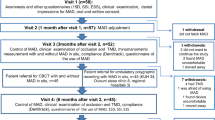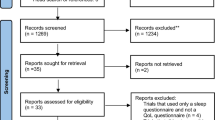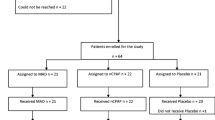Abstract
Purpose
To examine the craniofacial and airway morphology as well as the quality of life before and after passive myofunctional therapy (PMFT) for 1 year in children with obstructive sleep apnea (OSA).
Methods
Forty children with OSA wearing an oral device nightly (treatment group) and seventeen without the device (control group) were followed up for 1 year. Lateral cephalometric radiography, polysomnography (without participants wearing the oral device), and quality of life survey (OSA-18) were performed before and after the study period.
Results
The apnea-hypopnea index (AHI) during sleep, REM AHI, hypopnea count, and desaturation count in the treatment group dropped significantly, compared with the control group. The craniofacial linear measurements increased significantly in both groups, while the length of mandible (Co-Gn) and anterior facial height (N-Me) became significantly larger in the treatment group. For the airway morphology, the intergroup comparison showed that OPha-Ophp (distance between anterior and posterior sides of oropharynx) increased significantly in the treatment group. For quality of life, the intergroup comparison found statistically significant improvements in the following in the treatment group, based on the OSA-18 survey: loud snoring, dysphagia, mood swings, discipline problems, difficulty awakening, total score for the emotional distress portion, and total survey score.
Conclusions
Preliminary evidence is substantiated for the benefits of 1-year PMFT using an oral device with a built-in tongue bead, including improvements in nasal breathing during sleep, mandible linear growth (Co-Gn and N-Me), airway morphology (OPha-Ophp), and patients’ quality of life.




Similar content being viewed by others
References
Capua M, Ahmadi N, Shapiro C (2009) Overview of obstructive sleep apnea in children: exploring the role of dentists in diagnosis and treatment. J Can Dent Assoc 75(4):285–289
Bahammam A (2011) Obstructive sleep apnea: from simple upper airway obstruction to systemic inflammation. Ann Saudi Med 31(1):1–2
Lal C, Strange C, Bachman D (2012) Neurocognitive impairment in obstructive sleep apnea. Chest. 141(6):1601–1610
Katz ES, D’Ambrosio CM (2008) Pathophysiology of pediatric obstructive sleep apnea. Proc Am Thorac Soc 5(2):253–262
Huang YS, Guilleminault C (2013) Pediatric obstructive sleep apnea and the critical role of oral-facial growth: evidences. Front Neurol 3(184):1–7
Harvold EP, Tomer BS, Vargervik K, Chierici G (1981) Primate experiments on oral respiration. Am J Orthod 79(4):359–372
Miller AJ, Vargervik K, Chierici G (1984) Experimentally induced neuromuscular changes during and after nasal airway obstruction. Am J Orthod 85(5):385–392
Vargervik K, Miller AJ, Chierici G, Harvold E, Tomer BS (1984) Morphologic response to changes in neuromuscular patterns experimentally induced by altered modes of respiration. Am J Orthod 85(2):115–124
Rubin RM (1987) Effects of nasal airway obstruction on facial growth. Ear Nose Throat J 66(5):212–219
Vargervik K, Harvold EP (1987) Experiments on the interaction between orofacial function and morphology. Ear Nose Throat J. 66(5):201–208
Katyal V, Pamula Y, Martin AJ, Daynes CN, Kennedy JD, Sampson WJ (2013) Craniofacial and upper airway morphology in pediatric sleep-disordered breathing: systematic review and meta-analysis. Am J Orthod Dentofac Orthop 143(1):20–30
Flores-Mir C, Korayem M, Heo G, Witmans M, Major MP, Major PW (2013) Craniofacial morphological characteristics in children with obstructive sleep apnea syndrome: a systematic review and meta-analysis. J Am Dent Assoc 144(3):269–277
Huang YS, Guilleminault C, Lee LA, Lin CH, Hwang FM (2014) Treatment outcomes of adenotonsillectomy for children with obstructive sleep apnea: a prospective longitudinal study. Sleep. 37(1):71–76
Pirelli P, Saponara M, Guilleminault C (2004) Rapid maxillary expansion in children with obstructive sleep apnea syndrome. Sleep. 27(4):761–766
Camacho M, Certal V, Abdullatif J, Zaghi S, Ruoff CM, Capasso R, Kushida CA (2015) Myofunctional therapy to treat obstructive sleep apnea: a systematic review and meta-analysis. Sleep. 38(5):669–675
Villa MP, Brasili L, Ferretti A, Vitelli O, Rabasco J, Mazzotta AR, Pietropaoli N, Martella S (2015) Oropharyngeal exercises to reduce symptoms of OSA after AT. Sleep Breath 19(1):281–289
Huang YS, Chuang LC, Hervy-Auboiron M, Paiva P, Lin CH, Guilleminault C (2019) Neutral supporting mandibular advancement device with tongue bead for passive myofunctional therapy: a long term follow-up study. Sleep Med 60:69–74. https://doi.org/10.1016/j.sleep.2018.09.013
Chuang LC, Lian YC, Hervy-Auboiron M, Guilleminault C, Huang YS (2017) Passive myofunctional therapy applied on children with obstructive sleep apnea: a 6-month follow-up. J Formos Med Assoc 116(7):536–541
Lian YC, Huang YS, Guilleminault C, Chen KT, Hervy-Auboiron M, Chuang LC, Tsai AI (2017) The preliminary results of the differences in craniofacial and airway morphology between preterm and full-term children with obstructive sleep apnea. J Dent Sci 12(3):253–260
Villa MP, Bernkopf E, Pagani J et al (2002) Randomized controlled study of an oral jaw- positioning appliance for the treatment of obstructive sleep apnea in children with malocclusion. Am J Respir Crit Care Med 165(1):123–127
Fan Y C (1995) A study of radiographic cephalometric analysis and Taiwanese standards [thesis]. Taipei: National Taiwan University
Perez CV, de Leeuw R, Okeson JP, Carlson CR, Li HF, Bush HM, Falace DA (2013) The incidence and prevalence of temporomandibular disorders and posterior open bite in patients receiving mandibular advancement device therapy for obstructive sleep apnea. Sleep Breath 17(1):323–332
De Almeida FR, Lowe AA, Tsuiki S et al (2005) Long-term compliance and side effects of oral appliances used for the treatment of snoring and obstructive sleep apnea syndrome. J Clin Sleep Med 1(2):143–152
Chen H, Lowe AA, de Almeida FR, Fleetham JA, Wang JA (2008) Three-dimensional computer assisted study model analysis of long-term oral-appliance wear. Part 2. Side effects of oral appliances in obstructive sleep apnea patients. Am J Orthod Dentofac Orthop 134(3):408–417
Ngiam J, Balasubramaniam R, Darendeliler MA (2013) Clinical guidelines for oral appliance therapy in the treatment of snoring and obstructive sleep apnoea. Aust Dent J 58(4):408–419
Arens R, Marcus CL (2004) Pathophysiology of upper airway obstruction: a developmental perspective. Sleep. 27(5):997–1019
Arens R, McDonough JM, Corbin AM et al (2003) Upper airway size analysis by magnetic resonance imaging of children with obstructive sleep apnea syndrome. Am J Respir Crit Care Med 167(1):65–70
Arens R, McDonough JM, Costarino AT et al (2001) Magnetic resonance imaging of the upper airway structure of children with obstructive sleep apnea syndrome. Am J Respir Crit Care Med 164(4):698–703
Huon LK, Liu SY, Shih TT et al (2016) Dynamic upper airway collapse observed from sleep MRI: BMI-matched severe and mild OSA patients. Eur Arch Otorhinolaryngol 273(11):4021–4026
Funding
This study was supported by the Chang Gung Memorial Hospital (CMRPG3G1951 and CMRPG3H1591; Grant Recipient: Li-Chuan Chuang). The data of the study were first presented at the 5th International Pediatric Sleep Association Congress, Paris, April, 2018.
Author information
Authors and Affiliations
Corresponding author
Ethics declarations
Conflict of interest
The authors declare that they have no conflict of interest.
Ethical approval
All procedures performed in studies involving human participants were in accordance with the ethical standards of the Institutional Review Board of the Human Investigation Committee of Chang Gung Memorial Hospital and Chang Gung University (IRB 104-9308A3), as well as the 1964 Helsinki declaration and its later amendments or comparable ethical standards.
Informed consent
Informed consent from the legal guardian of each participant was obtained prior to the investigation.
Additional information
Publisher’s note
Springer Nature remains neutral with regard to jurisdictional claims in published maps and institutional affiliations.
Rights and permissions
About this article
Cite this article
Chuang, LC., Hwang, YJ., Lian, YC. et al. Changes in craniofacial and airway morphology as well as quality of life after passive myofunctional therapy in children with obstructive sleep apnea: a comparative cohort study. Sleep Breath 23, 1359–1369 (2019). https://doi.org/10.1007/s11325-019-01929-w
Received:
Revised:
Accepted:
Published:
Issue Date:
DOI: https://doi.org/10.1007/s11325-019-01929-w




